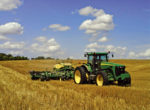Advertise Follow Us
Articles Tagged with ''pests''
Encouraging Good Insects And Limiting The Bad Ones
No-till and biodiversity can preserve beneficial insect populations that naturally control crop pests, and possibly reduce insecticide usage, says a USDA expert.
Read More
What I've Learned from No-Tilling
Efficient Fertility, Cover Crops Set The Table For A Life Of No-Till
Cover crops, specialty products and strategic fertilizer placement provide a yield boost for veteran Pennsylvania no-tiller H. Grant Troop.
Read More
No-Till Notes
Scout For These No-Till Soybean Pests
A little research, some timely exploration of your fields and an eye for detail will help you keep insects and diseases in check.
Read More
6 Steps To Improve Sprayer Performance
A thorough checkup and taking advantage of new technology can enhance the effectiveness of your spraying applications.
Read More
8 Ways To Make No-Till Wheat A Winner
Choosing the right varieties, herbicides and seeder are among the keys to successfully adding wheat to rotations, says Kentucky no-tiller John Young.
Read More







